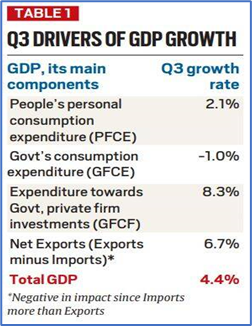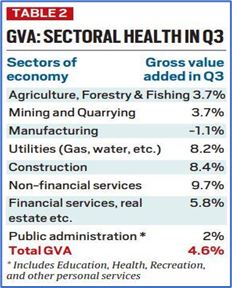Why in News?
- The Ministry of Statistics and Programme Implementation (MoSPI) released economic growth data – Gross Domestic Product (GDP) and Gross Value Added (GVA) — for the third quarter (Q3 or October to December) of the current financial year (2022-23 or FY23).
What’s in today’s article?
- Basics (GDP, GVA, Similarities, GDP Components, etc.)
- Q3 Data (GDP Data, GVA Data, Future Outlook, etc.)
What is GDP?
- The total monetary or market value of all finished goods and services produced within a country’s borders within a specific period of time is called its gross domestic product (GDP).
- It is a comprehensive measure of the country’s economic health, expressed in terms of the overall domestic production and functions.
- The GDP of a country includes all private and public consumption, government outlays, investments, additions to private inventories, paid-in construction costs, and foreign balance of trade.
What is GVA?
- In situations where the GDP fails to measure the real economic scenario, the Gross Value Added (GVA) is a better gauge.
- The GVA measures the total value of goods and services produced in an economy, and the amount of value added to a product.
- It is defined as the output produced after the deduction of the intermediate value of consumption. The GVA, in India, is measured at ‘basic prices’.
Further Breakdown of GDP Components:
- Under GDP, there are four main heads –
- Private Final Consumption Expenditure (PFCE) or the money spent by people on goods and services for personal consumption; this is the biggest contributor of GDP, accounting for almost 55%-60% of the GDP.
- Government Final Consumption Expenditure (GFCE) or the money spent by governments towards its daily needs; this accounts for 10% of GDP.
- Gross Fixed Capital Formation (GFCF) or the money spent by private firms and governments towards building productive capacities (investments); this is accounts for 30%-32% of GDP.
- Net of exports and imports; this is typically a negative impulse to GDP because imports are more than exports, implying money going out of the country.
How are GDP and GVA Related?
- GDP and GVA are related as follows –
- GDP = GVA + Taxes levied by governments on products – Subsidies provided by government on products
- Typically, the absolute level of GDP is more than the absolute level of GVA because taxes received are more than subsidies spent by the government.
Data Released by MoSPI for Q3 of FY23:
- The Ministry of Statistics and Programme Implementation (MoSPI) released economic growth data for the third quarter (October to December) of the current financial year (2022-23 or FY23).
- In terms of GDP, the growth rate has decelerated to 4.4% in Q3.

- The main growth impulse has come from the spending towards investments in the economy.
- This is a good sign as increase in investments typically augurs well for sustaining an economy’s growth momentum.
- However, the biggest worry has been on the personal consumption front. A slowdown in private consumption, the biggest engine of GDP growth, can eventually disincentivise investments.
- Government’s expenditures have also seen a decline. This is likely the result of the government trying to meet fiscal deficit parameters.
- GVA Data –

- This is the second consecutive quarter when manufacturing, which is often viewed as a source of creating jobs, has contracted.
- However, robust growth in the construction sector as well as services (both financial and non-financial) are a relief.
Indian Economy’s Outlook:
- India’s economy was fast losing momentum before Covid-19 Pandemic led to a contraction.
- Coming out of the pandemic, India’s economy has reclaimed the mantle of the fastest-growing major economy in the world.
- However, data suggests that India is losing this momentum. It is likely to slow down from 9.1% in FY22 to under 7% in FY23.
- Factors Behind this Contraction –
- Fading away of the pent-up demand from the lockdown period,
- Tighter Fiscal & Monetary Policy rates











